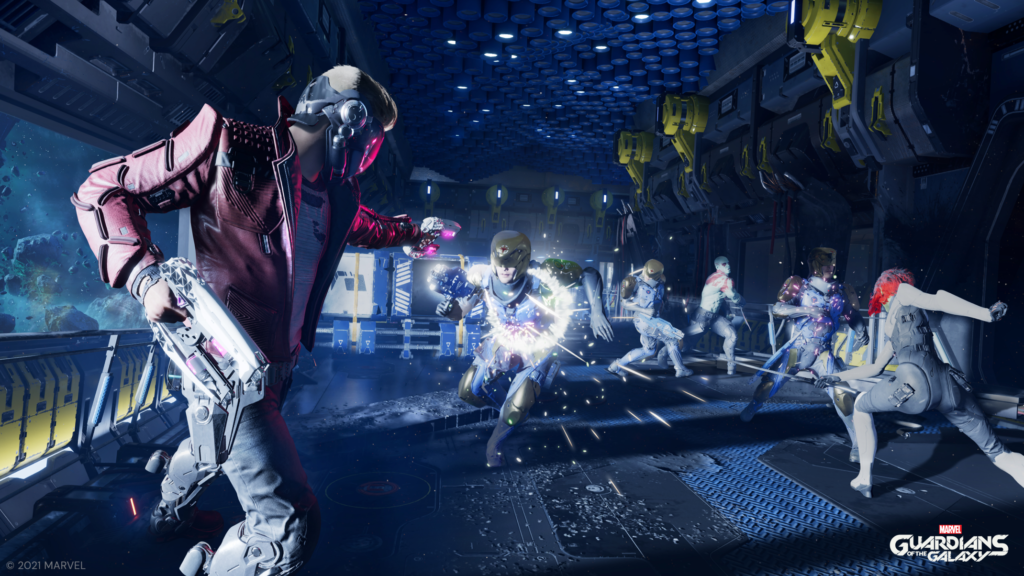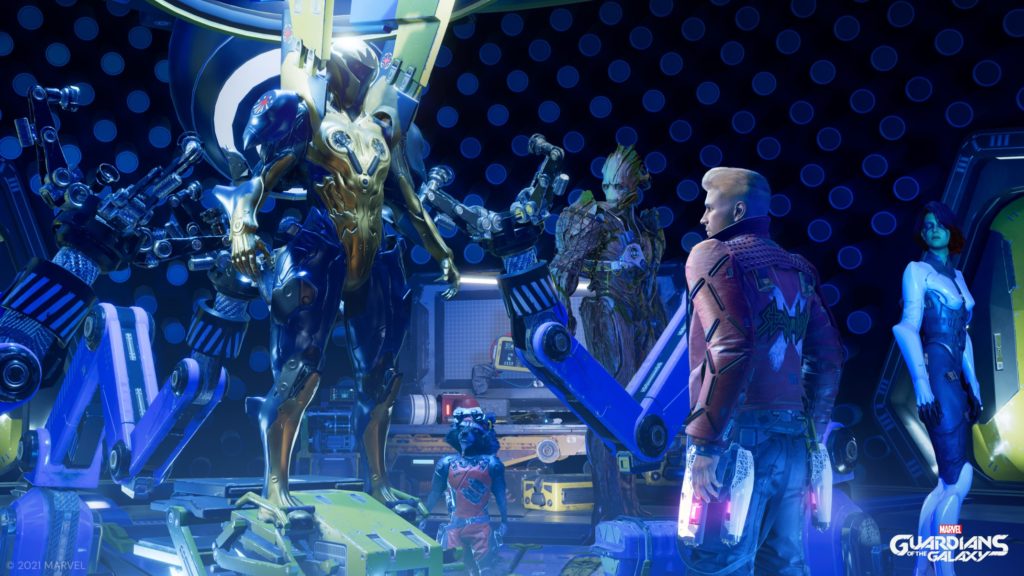Hands-on play through an entire chapter suggests that Square Enix’s Guardians of the Galaxy should turn out to be pretty much the game we’ve all been hoping for.
Square Enix’s deal to create games based on the Marvel Cinematic Universe got off to a slightly false start in the form of the disappointing Marvel’s Avengers, but its next Marvel game off the block, Guardians of the Galaxy, presents a much more enticing prospect. On paper, it’s exactly the sort of Guardians of the Galaxy game that fans would want: single-player only, narrative-led and endowed with gameplay that mixes brawling, shooting and puzzling, playing to the differing skills of the motley band of Guardians.
Square Enix gave us a chance to ascertain whether Guardians of the Galaxy’s execution lives up to expectations, via a hands-on preview at the Anglo-Japanese publisher’s London office. And we’re happy to report that early indications suggest it does – with the usual preview caveats meaning there’s no way of telling how meaty or otherwise it will be, or whether its gameplay will show a healthy degree of progression.
However, we can testify that as a game, Guardians of the Galaxy – developed by Eidos Montreal – captures the unique Guardians of the Galaxy atmosphere with plenty of panache: it’s constantly shot through with amusing banter and cheesy 80s music, it looks and feels utterly authentic, and its gameplay feels distinctive and fun.
On the Milano
Square Enix broke from a rather annoying convention with the Guardians of the Galaxy preview: instead of presenting us with a tutorial followed by an all-too-brief taste of later gameplay, it let us play through the entirety of the game’s chapter 5, about four hours into its storyline. Supporting the gameplay with a number of short videos made by various members of the development team, it informed us that chapter five – entitled Due or Die – took place after the team of mismatched aliens had just escaped from a hairy encounter with Lady Hellbender in her fortress.

So Peter Quill – aka Star-Lord – Drax, Gamora, Groot and Rocket started the chapter on their spaceship, the Milano. Which, essentially, is their home, so it was easy to see the care that Eidos Montreal had invested in crafting it. Banter between the ensemble cast was constant and unrelenting, and there was plenty to explore in the Milano. We also performed a bit of character development using a workbench, which converts the scrap you find in the game into perks for Quill. Among those were a perfect dodge, a charge-shot for his blaster and a jet-boot upgrade which let him hover around for a while. Character development in Guardians of the Galaxy is also taken care of by an Ability Points system which encompasses all the Guardians and lets you beef up things like melee and blaster damage.
On the Milano, we encountered another addition to the motley crew of Guardians: Kammy, a purple llama. Eidos Montreal said that Kammy would later develop into a useful member of the team, but in chapter 5, she had chewed up part of the ship, destroying the comms array.
Which was problematic, since the task in hand involved paying a fine the Guardians had incurred from Nova Corps, the galactic police force. The Guardians tried contacting Ko-Rel, the Nova Corps Centurion who issued the fine, but comms were impossibly garbled, so it was agreed, after some conversation, to head to the Rock, the nearest Nova Corps outpost. We went to the Milano’s bridge and punched in the co-ordinates.
Mystery on the Rock
On arrival at the Rock, something was clearly amiss. It appeared to be deserted and there was evidence of an incursion. As we explored, we were able to sample some new gameplay mechanics, including puzzling. Faced with a locked door, for example, we scanned the area with Quill’s visor and found a duct into the next room; after blasting the cover off that, we sent Rocket through it – although, cutely, the ever-rebellious raccoon demurred at first and we had to ask him twice.
In another room, we directed Rocket as he used his hacking skills to solve another puzzle: reorienting power nodes to open a door, along similar lines to Watch Dogs’ hacking puzzles. And we experienced one of Guardians of the Galaxy’s decision moments, which occasionally crop up and which influence how each chapter plays out.

In that particular case, the Guardians came across a discarded Nova Corps Centurion helmet equipped with a comms device, and, when putting it on, Quill had to choose whether to remain silent or to say something. Our progress through the chapter had triggered some story-advancing cut-scenes: the Guardians had finally seen some Nova Corps Centurions in the Rock, but many of them were suffused with a strange purple glow, and were observed participating in a quasi-religious ritual. Opting to talk over the helmet’s comms was the wrong call: it alerted the hostile possessed Centurions to our presence; if we had remained silent, we would have been able to ambush a few groups and thin out the volume of enemies before the culminating boss-battle.
Frenetic, tactical combat
Towards the end of the chapter, we finally got to experience the gameplay mechanic at the very heart of Guardians of the Galaxy: combat. Overall, it impressed, with a distinct identity of its own, as it managed to mix shooting with brawling in a seamless manner.
Momentum was key: flurries of attacks and combos generated excitable adjectives indicating that our battlefield momentum was building, which in turn allowed the various Guardians to launch one-off special attacks. Our Huddle Meter was building, too. The Huddle was an archetypically Guardians of the Galaxy mechanism, triggered by hitting both bumpers, which cut us away from the action into a huddle with the Guardians. Quill had to listen to what they were saying and pick the appropriate motivational speech: calming them down if they were overconfident and so on. On returning to the action, that then triggered a team-wide buff (or one that applied to Quill only if you picked the wrong speech option) which lasted for a while. Soon, we were carefully picking the right moments to trigger a Huddle and take advantage of the resulting boost to damage and defence.
Warming up by taking on a mini-boss – a Grenadier equipped with a shield, able to launch electric mines which caused huge amounts of damage while moving across the battlefield – revealed that Quill’s melee attacks caused much more damage than his blaster. However, his blaster also had an alternative freeze-shot – one of what looked like a potential four elemental shots. That proved useful as a means of stopping the Grenadier briefly, enabling the Guardians to get behind him and inflict large amounts of close-range damage until he thawed.

Scanning enemies using Quill’s visor provided a means of highlighting them to be dealt with by specific Guardians, and when the Grenadier’s health fell below a certain level, it became possible to launch a joint attack with two Guardians that finished him off. There were also environmental attacks on offer, such as explosive drums which you could direct Drax to pick up and throw at enemies.
The main battle threw a lot of enemies at us: a mix of normal Centurions and Grenadiers, necessitating a considered, tactical approach. Finishing off enemies regenerated our health, which led us to prioritise dispatching the more dangerous enemies first, keeping the easier ones in reserve for times when health was low. It was important to pair Guardians up with appropriate enemies: Gamora, for example, caused the biggest amount of melee damage, Groot was good at immobilising enemies and Rocket was effective with ranged weaponry, so each combination of enemies we encountered necessitated a subtly different tactical approach.
Guardians of the Galaxy’s combat, then, provided quite the spectacle – large-scale, over-the-top battling performed to a backdrop of the cheesy 80s music for which the films are renowned (Eidos Montreal has also written an original soundtrack album for the game). As well as being great to behold, it felt refreshingly distinctive and sufficiently challenging as to exercise our tactical muscles. It certainly felt like it did justice to the stylised and exciting combat seen in the films.
Beyond the Rock: opening up the story
Our battle against the warped Nova Corps operatives eventually morphed into a rearguard as we fought our way back to the Milano, shooting out docking clamps while still under attack, and managed to escape. Eidos Montreal gave us some insight into where the story would then go – the end of chapter 5, apparently, will be a pivotal point in the game.
That’s because the Guardians would then head to Knowhere, a familiar setting from the films, at which point a number of encounters with familiar characters would open up various story strands, bringing about a much less linear approach to how the narrative would subsequently unfold.
The gameplay we encountered in chapter 5 was very linear, so any move away from that would be very welcome. Bearing that in mind, along with the way in which Eidos Montreal has absolutely nailed the vibe and detail of the Guardians of the Galaxy universe, and paired it with intriguingly distinctive combat, it felt as though we were playing pretty much the exact game which any Guardians of the Galaxy fan would crave. If, in its final form, it proves sufficiently meaty, and hangs together well in narrative terms, Guardians of the Galaxy should be a big hit.
